RESEARCH & REPORTS
Direct Mail Marketing during COVID-19: Statistics and Marketing Trends — Part 2
The ongoing coronavirus pandemic has changed so much about our lives this year, so how has direct mail marketing responded?
The ongoing coronavirus pandemic has changed so much about our lives this year, so how has direct mail marketing responded?
In the broadest sense, it’s fair to say that as consumer lifestyles have shifted over the past seven months, so have marketing campaigns from companies in many industry categories and subcategories. COVID-19 has pushed many consumers to shop, think about, and buy differently more than any single cause in the past several decades.
Think of the impact that’s been made. Overall mail volume is down, though not as much as originally forecast or feared. But what’s been in the mail has seen changes and shifts that may ultimately mean greater change than recessions or other extraordinary events.
Recommended reading: 18 Direct Mail Marketing Trends for 2021
So how have industry categories fared during the last four months of the pandemic? Analyzing data based on the mail we’ve collected at Who’s Mailing What!, we’ve uncovered some new trends on direct mail activity. Here’s a look at the mail received by our panelists from January to October.
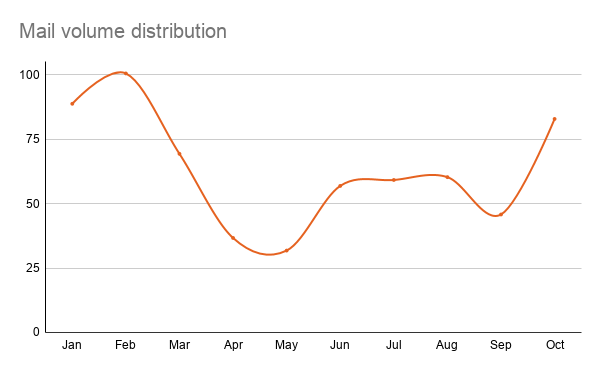
The Use of COVID-related Words in 2020 and 2021
Looking at words and phrases related to COVID, comparing 2020 with 2021, we see the word “virtual” being used in copy and gaining in popularity.
In 2020, we were adapting and canceling. In 2021, you can see we’ve been adapting and transitioning to virtual environments.
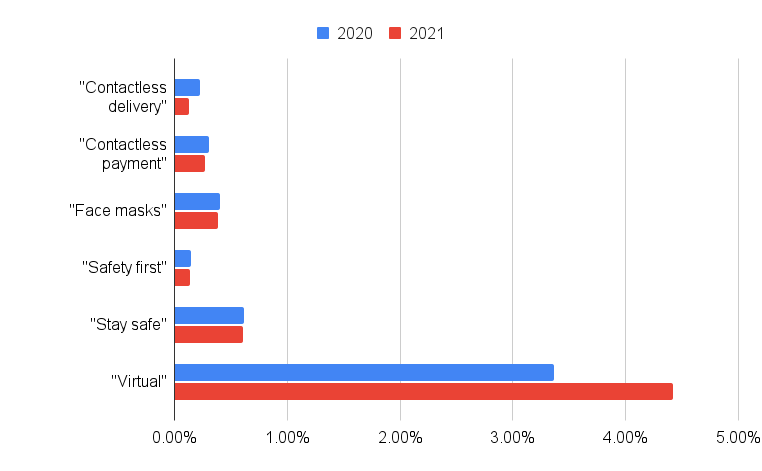
What Happened from February 2020 through May 2020
A few months ago, we reviewed the initial impact of COVID-19 on direct mail activity. Figures covering the months of February through April (later updated through May) showed that the amount of mail we recorded from our network of panelists around the country declined.
This made sense; companies pulled or canceled their mail campaigns as lockdowns were put in place, forcing many businesses (among other entities) to close.
Essential businesses though, adjusted their messaging to reach customers. After all, people still need to buy groceries, meals, vehicle services, medicine, clothing … you get the idea. Because of stay-at-home orders and so much uncertainty, some segments thrived, like home and garden supplies. As restrictions and mandates expired, businesses began to reopen with new safety measures to protect their customers and employees.
What Happened from June 2020 through September 2020
An overview of our entire mailstream shows a variety of changes for major categories from June to September.
-
- Finance, for example, slightly increased, making up 22.6% of mailings in June and 25.5% in September.
- Internet Services, however, which was 6.6% of mail in June, surged to 7.7% in September.
- Recreation & Travel, which had been 3.2% of the mail in February and crashed to 1.9% in June, rebounded to 2.5% in September.
- Nonprofit mail grew from 6.8% in February to 13.4% in June and 15.5% in September, which makes sense given the growing needs of organizations in all sectors due to the new health and economic conditions.
- Business Services declined from 4.5% of all mail in June to only 3% in September, reflecting great continued uncertainty over business conditions; if you’re not very confident about your prospects and current customers being able to buy from you, you’re going to be more cautious about when and how much to mail.
- Healthcare direct mail,which had been 6% in June, decreased to 4.5% in September.
- Retail was remarkably stable, measuring a 26.6% share in June and 26.7% of all mail in September. As retailers emerged from lockdowns in late spring into summer, they were cautious about raising their mail volume, though there was a slight uptick in August for back-to-school marketing before a dip in September.
The top 5 categories of mail volume in June — Retail, Finance, Nonprofit, Internet/Telecom, Healthcare – were exactly the same in September at roughly the same percentages (see below chart).

Furthermore, there have been changes within categories that bear mentioning.
- For example, consider Recreation & Travel. The virus and the changing response to it have caused dramatic swings over the past few months in what’s been marketed.
- Sports mailings were 9.7% of the total from this category in April. They have since declined to where there were only 3.3% in September, reflecting the cancelation of so many games and competitions.
- Hotels and Resort mailing total percentages decreased the same way. This indicates a very soft market for business, as well as leisure travel is anticipated for the coming months.
- But then, look at the Gambling subcategory. It made 42.5% of travel mailings in April and reached a whopping 55% in September. With indoor public capacities increased and new safety measures in place, casinos felt more comfortable reaching out to consumers eager to spend a few hours away from home.
- Also, Airlines — which dropped off the map during the early months of the pandemic — were responsible for 10% of travel mailings in September. Again, the lifting of some restrictions and the establishment of safety protocols at airports and on planes has given airlines more confidence to market flying again, even if cautiously.
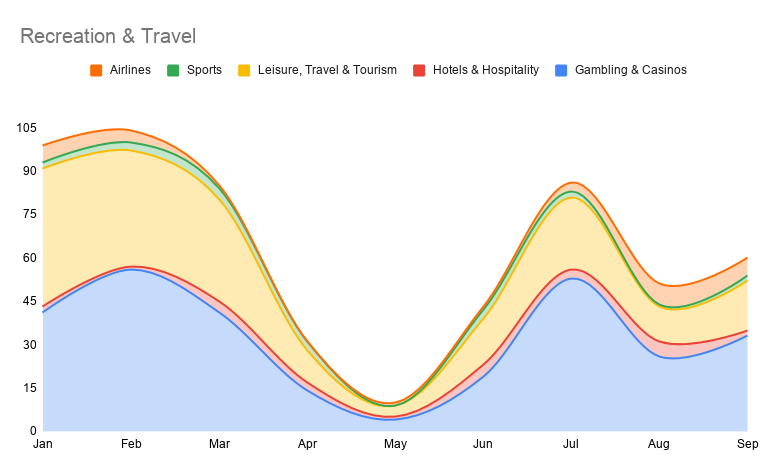
Other changes took place that are worth noting:
- In the Sporting Goods subcategory, there was a rise over the spring up until June as closed fitness facilities and gyms forced consumers to purchase their own equipment for home use.
- As these mailings declined into September, there was an increase in mail in the Wellness/Fitness subcategory, resulting from the reopening of gyms with new safety measures now in place after health restrictions eased.

- And Internet Services? This category has seen a rise since the early months of the pandemic when more employees and schoolkids had to log in from home. After reaching a new high with 6.9% of all mail in May, this group rose to 7.7% of mail in September, again reflecting the influence of back-to-school spending as more students adjusted to hybrid or fully learn-at-home schedules.
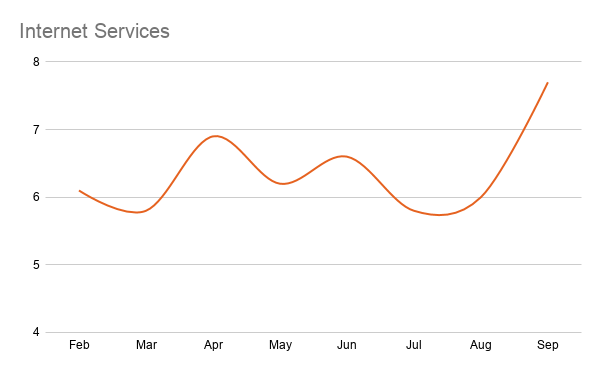
Marketing Changes since the Start of Coronavirus
After much uncertainty and even chaos in the early days of the pandemic’s arrival in the U.S., marketers have adjusted to the “new normal” in some interesting ways. There isn’t much choice in the matter, really. Conditions have changed, no one knows for how long, so businesses and nonprofits can either adapt to survive (and possibly thrive), or not, and take their chances.
Let’s see how COVID-19 has changed things using before and after snapshots of actual mail pieces that have been captured by us at Who’s Mailing What!
#1 Trend — the Rise of Virtual Everything
The postcard on the top was mailed pre-shutdown in March by Penn State University to market an in-person tour of its York campus in April. Notice that it was planned to be the typical college tour experience with lots of up-close visits to campus spaces and personal interactions. That didn’t happen.
The postcard on the bottom from Pepperdine University was mailed in July. It offers prospective students a safe alternative: the virtual experience.
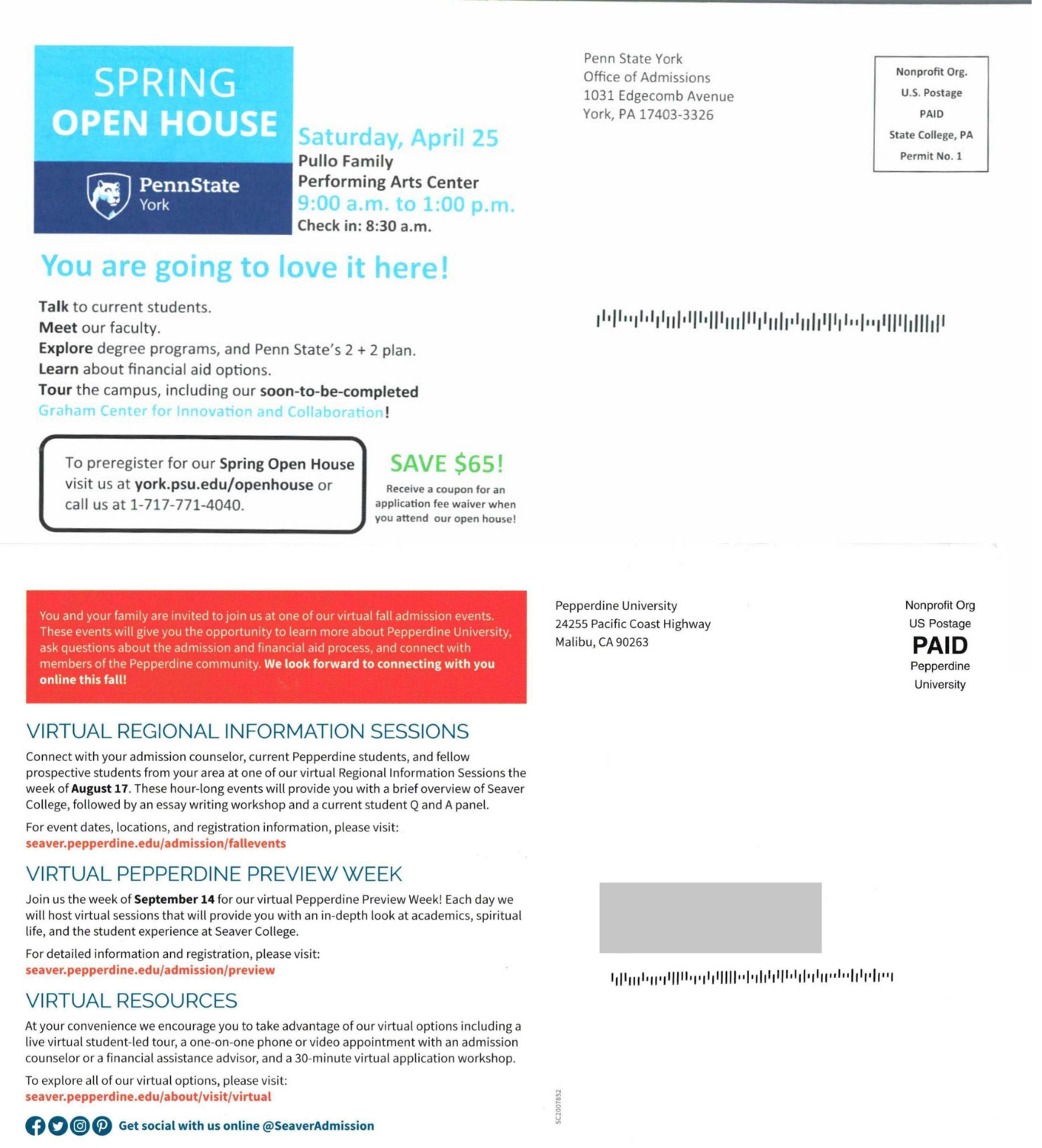
#2 Trend — a Healthcare Pivot
At the top, this Highmark Direct Store mailer from January 2020 encourages Medicare members to call a toll-free number to schedule an appointment, or “simply stop in during business hours”. But that was then, before COVID-19. Today, in many, if not most places, people can’t drop by a medical facility for a quick chat.
The postcard underneath mailed by healthcare system Houston Methodist in May advises a new and very likely standard option for the medical sector: virtual healthcare appointments.

#3 Trend — Promoting Virtual Events
Though this is related to the previous trend, it’s important enough that it deserves its own entry. As coronavirus swept across the world, events of all kinds were postponed or canceled outright.
No conferences, conventions, or seminars means that in many B2B subcategories, people have to find another way to conduct meetings, deliver speeches, train employees, educate attendees, and network with colleagues, vendors, and the general public.
Enter Zoom, BlueJeans, GoToMeeting, and other companies with their Web-based solutions.
In the example on the left below, Acres U.S.A. promoted its annual convention way back in 2007 with a self-mailer. And in 2020? The same, this time noting that this year’s program is moving online because of COVID-19.

Large in-person gatherings are likely to be out of the picture for quite a while yet. So with direct mail, companies and organizations can reach out with a tactile mail piece that sets their event apart from the others that have also been forced to move online.
#4 Trend — Safety Measures as Strong Benefits
In the first example on the top from 2015, Delivery.com checked off the benefits of using the app to order meals from local restaurants, like wide selection, ability to earn points, and convenient ordering.
The second Delivery.com postcard below — from September 2020 — also lists three benefits but they’re different ones than the previous effort. Now, this postcard emphasizes the safety of using the company because of measures like masks, contactless delivery, and sanitation procedures.

#5 Trend – Grow Your Business with New Products & Services
As I stated before, many companies have adapted to COVID-19 by adding new services and products that meet the wants and needs of their customers.
Here’s an example. Prior to COVID-19, National Pen Corp.’s line of promotional products included pens, stationery, drinkware, apparel, bags, and calendars. So the piece on the left below markets a customized pen to a past customer.
The letter on the left, though, from August 2020, promotes a necessity: a face mask. Companies can have them personalized to promote themselves to their customers and employees. The same goes for other health-oriented items added to the company’s offerings, such as sanitizers, no-touch tools, personal protective equipment (PPE), and signage (including social distancing stickers).

#6 Trend – Marketers are Adapting to the “New Normal”
Marketers are adapting to a new normal and including COVID-related messages into their campaigns. In this example, the dental office simply slimmed down the box with its offer and added a COVID-related copy. It was that simple.
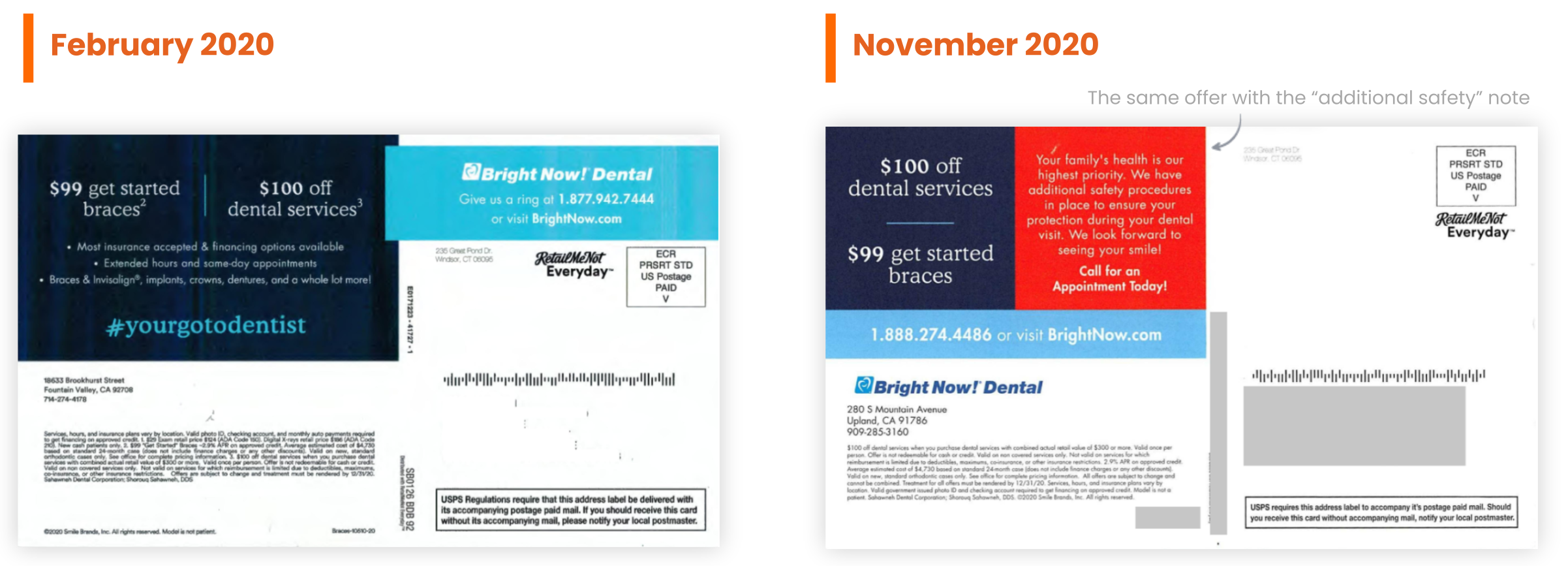
Final Thoughts
Well, we’re about nine months into the pandemic, and even as America and the world continues to deal with its threat, marketers, as we’ve shown, have found ways to continue offering products and services that meet people’s needs and wants.
Future shutdown and reopening cycles will require that marketers be more nimble and in tune with their customers than ever before. As we noted in our first analysis of COVID-19 mail a few months ago, practice empathy and be positive. Customers want to feel that they are in control. At the same time, they want to know that you care about their concerns, such as financial and health security. They need reassurance that you are taking measures to keep them and the larger community safe during these difficult times.
This article was originally published on Nov. 4th, 2020. It was updated and republished on Feb. 2nd, 2021.




















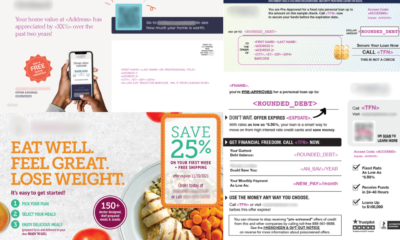


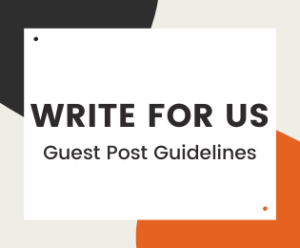





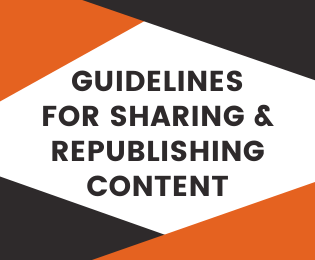

Demi
January 7, 2021 at 5:48 pm
This website was… how do I say it? Relevant!! Finally I have found something which helped me.
Thanks a lot!
Bertha
January 8, 2021 at 6:48 am
Hello my loved one! I want to say that this article is amazing, nice
written and include approximately all vital infos. I would like to look extra posts like this .